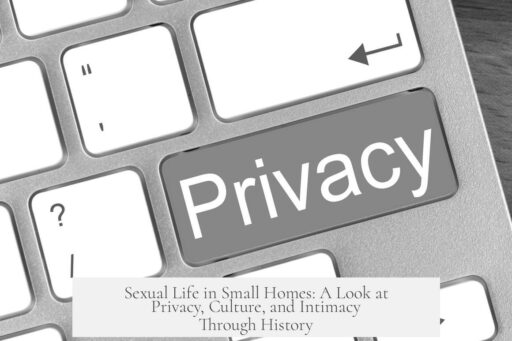When most people lived in one-room or one-bedroom homes, sex was far less private than it is today. Couples often engaged in sexual activity in shared spaces where children and other relatives were present. There was little sense of sexual privacy or taboo surrounding intimate acts.
Historically, during the late Middle Ages and early Renaissance in Europe, many households consisted of a single room with a shared bed for the entire family. This arrangement meant that sexual activity frequently occurred in the same space where children slept and lived. Children were likely aware of or even witnesses to sexual acts. There was no strong cultural pressure to conceal such behavior.
Sexuality had a different societal status at the time. It was common for acts that would now be considered private to take place semi-publicly. Evidence from the period includes the existence of “Cock and Hen” bars in London, where non-penetrative sexual acts were openly performed. Public displays of sexuality were not the focus of intense moral condemnation as they later became.
The concept of privacy, especially related to sexuality, was not well developed before the 16th century. Attempts were made to find private spaces, but these did not reflect the privacy standards we recognize today. Spaces like bedchambers initially served multiple functions, including social gatherings or general living areas, rather than exclusively private sleeping quarters.
The major turning point came during and after the 16th century, through what historians call “the invention of privacy.” Architectural advances allowed buildings to have multiple rooms. This innovation facilitated creating private spaces dedicated to individual or couple use. The “creation of the upstairs” and cheaper building materials helped segregate living areas, thus introducing physical means of privacy.
Religious reforms also influenced this shift profoundly. The Protestant Reformation, sparked by Martin Luther, advanced stricter sexual morality. It emphasized that sex should be confined to marriage and conducted privately. The reformers encouraged the development of private marital spaces, reinforcing privacy norms. This religious movement also imposed harsher sanctions on any sexual acts outside marriage.
Simultaneously, the Catholic Counter-Reformation addressed marriage and sexuality. The Council of Trent mandated that marriages be publicly witnessed by a priest and two witnesses to be valid. Before this, clandestine marriages were common, often leaving women vulnerable. Catholicism moved to regulate sexual behavior through formal marriage rites, indirectly fostering a more private understanding of sexual relationships within marriage.
The combined impact of religious reforms and architectural innovation drove a cultural shift. Sexual activity gradually moved from public or semi-public occasions to private encounters behind closed doors. This transition started among the upper classes and eventually spread to middle and lower social classes. It redefined sexual intimacy as a private matter rather than a communal or accepted visible reality.
Interestingly, the historical lack of sexual privacy contrasts sharply with modern norms, especially in Western societies, which emphasize individual privacy and sexual discretion. Yet, in some contemporary societies where people still live in small, shared quarters, questions remain about how modern privacy taboos apply or differ compared to historical or other cultural contexts.
| Period | Living Arrangement | Sexual Privacy | Societal Norms |
|---|---|---|---|
| Late Middle Ages/Early Renaissance | One room with shared bed | Minimal to none | Sex open; children present; little taboo |
| 16th Century Onward | Multiple rooms emerging | Growing privacy through architecture | Religious reforms enforcing marital privacy and moral codes |
| Post-Council of Trent | Separate rooms typical for classes | Private sexual acts expected | Formal marriage rites; stricter sexual morality |
Overall, when homes consisted of one room or one bedroom, the notion of sexual privacy was virtually absent. The shift to private sexuality coincided with architectural advances, religious reforms, and changes in social ideas. These factors combined over centuries to redefine sex as a private, intimate act distinct from everyday public life.
- Sex was commonly performed in shared family spaces with little concealment in one-room homes.
- The invention of privacy in the 16th century created private bedrooms and changed sexual norms.
- Religious reforms emphasized marital chastity and privacy, increasing the social demand for sexual discretion.
- The transition from public/semi-public to private sexuality started among elites and spread down classes.
- Modern private sexual norms stem from these architectural and cultural shifts.
What Was Sex Like When Most People Lived in 1 Room or 1 Bedroom Homes?

Sex back then? It was often a public—or at least semi-public—affair. For households cramped into one room with a single shared bed, privacy wasn’t a thing. Couple intimacy happened with kids and relatives right there, and there was little to no taboo around it. Sounds surprising? Let’s unpack this fascinating slice of human history and see how our current notions of sexual privacy evolved.
Imagine a typical household in late medieval Europe, roughly the 14th to 16th centuries. Many families, regardless of their social class, squeezed into a single room. This room usually served as living area, kitchen, and bedroom for everyone. The entire family shared one bed at night. Yes, all of them.
How did that affect sex? Well, sexual activity didn’t occur behind closed doors or with whispered discretion like today. Kids often slept in the same bed and were quite possibly aware of their parents’ intimate moments. To them, sex wasn’t scandalous or discreet; it was just part of everyday life.
This lack of sexual privacy was normalized—there was no prevailing sense of shame or secretiveness attached to it. In fact, there was no concept as explicit as “sexual privacy.” This stems from what historians call “the invention of privacy.”
The Invention of Privacy: When Did Sex Go Private?
The shift to private sexuality was slow and tied to architectural and social transformations that began around the 16th and 17th centuries. As building materials became cheaper and architectural knowledge spread, homes evolved from single-room spaces to multiple rooms with better heating. Suddenly, “the upstairs” or separate chambers appeared, creating physical barriers between family members.
This architectural change allowed private spaces for couples to be alone—spaces dedicated to sleep and intimacy rather than shared by the whole family or used for social gatherings. The bedroom became a private sanctuary instead of a communal spot.
Alongside architecture, major religious movements played a crucial role. The Protestant Reformation, sparked by Martin Luther, pressured society towards stricter sexual morals. It demanded that sex be confined within marriage and vigorously policed any deviations from this rule.
Luther and the Protestants tied sexual morality to sanctity and privacy, integrating private sexual conduct into the cultural consciousness. This revolutionary shift framed sex not as a communal event but as an intimate act to be kept behind closed doors.
Public Sex Was Once Not So Rare
Before these shifts, sexual acts sometimes happened openly, even outside the home. London’s infamous “Cock and Hen” bars were like early singles bars where nonpenetrative sexual activities were on semi-public display. Street sexual acts could also occur, and few paid much attention or reacted negatively.
Curiously, it took police nearly fifty years after the Metropolitan Police’s founding in London to enforce moral codes related to sexual behavior. This tells us that prior to the 19th century, sexual activities hadn’t yet fully shifted into the private sphere with expected decorum.
The Catholic Response: Formalizing Marriage and Sexual Privacy
The Catholic Counter-Reformation added a layer of official control to these evolving norms. At the Council of Trent, Church authorities noted serious lapses in clergy behavior, including secret marriages and concubinage, which muddled legal and moral boundaries.
To protect women from abandonment due to clandestine marriages, the Church introduced the Tamesti decree. It required that all Catholic marriages be publicly celebrated before a priest and witnesses. This formalization bolstered legal recognition around sexual unions and privacy within marriage.
Thus, marriage became not only a spiritual covenant but also a regulated institution with clear boundaries about sex and privacy, in contrast to the previously fluid, communal living arrangements.
From Public to Private: A Gradual Cultural Shift

The cultural idea of sex moving from public to private life didn’t happen overnight. Initially, these new norms emerged among the upper classes, who had the wealth to afford bigger houses and separate bedrooms. Over time, middle and lower classes began adopting these ideals as well.
Cultural, religious, and architectural changes intertwined to yield the modern view that sexual intimacy belongs strictly behind closed doors, away from children and relatives. Yet, some remnants of the old openness persist in folklore and social customs even today.
So, What Does This Mean for People Living in One-Room Homes Today?
Interestingly, in many parts of the world, large segments of the population still inhabit single-room or one-bedroom homes, due to economic or cultural reasons. This raises fascinating questions: how is sexual privacy handled today in such settings? How do modern taboos compare to historical ones? Is there a cultural gap between Western and Eastern societies on notions of sexual privacy?
While historical one-room households had almost no sexual privacy as we think of it, modern societies might implement alternative methods to balance intimacy and living constraints. These could include scheduled private times, go-to spaces like outside or secluded spots, or cultural attitudes toward more open family dynamics that differ significantly from Western taboos.
Lessons from History on Privacy and Intimacy
The history of sex in one-room homes illuminates that sexual privacy is a cultural invention, not a universal constant. It evolved with changing living standards, architectural innovations, and religious reforms. Today’s rigid boundaries around sex might feel natural, but they are relatively recent social constructs.
Couples living in tight quarters today can look back and take note: humanity once managed sex as a communal activity, sometimes with children present and no embarrassment. This perspective can spark fresh questions about how intimacy fits in diverse living arrangements worldwide.
Practical Tips for Navigating Sexual Privacy in Small Spaces
- Set Boundaries: Even if space is limited, communicate openly with family members about times for personal privacy.
- Use Creative Spaces: Find nooks, corners, or times when others are away to have intimacy.
- Respect Cultural Norms: Understand local attitudes toward sex and privacy to strike a comfortable balance.
- Adopt Flexible Schedules: Sometimes intimacy can be scheduled around others’ routines to create “private” moments.
Living in one-room or one-bedroom homes doesn’t necessarily eliminate sexual intimacy or privacy but requires adaptation and respect for shared spaces.
Final Thoughts
The story of sex in one-room homes reminds us that cultural norms evolve and privacy is a human-made concept that reflects social, economic, and religious forces. It challenges assumptions about sexuality, family life, and the spaces we inhabit.
So the next time you fret about locking your bedroom door, remember: your medieval predecessors might have been making love within arm’s reach of their whole household! That historical perspective might just make your “privacy problems” seem a bit more manageable.




